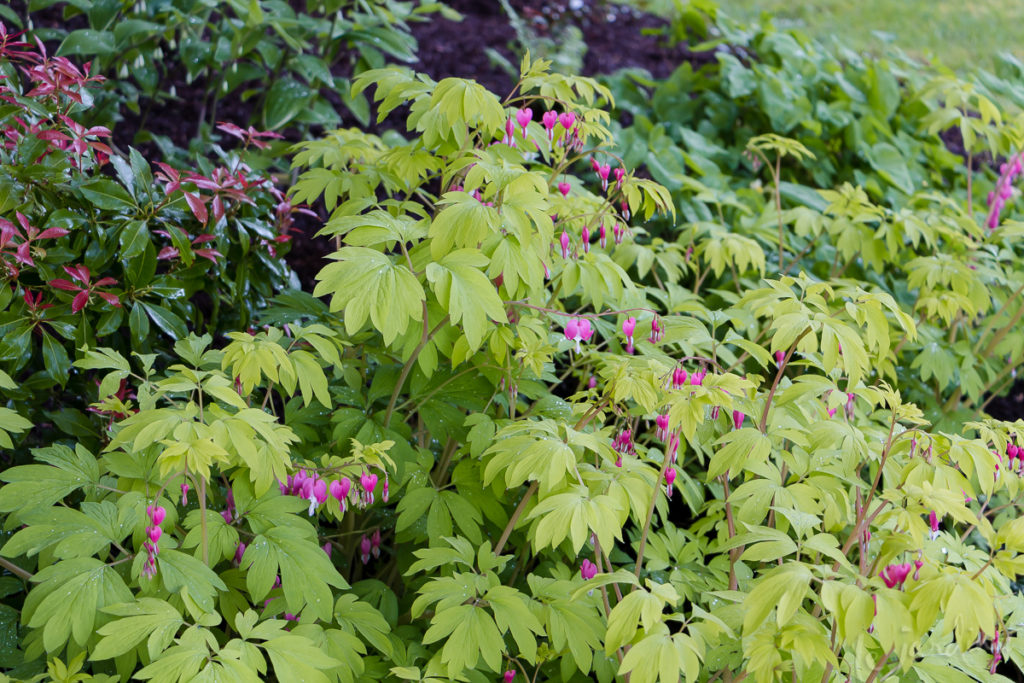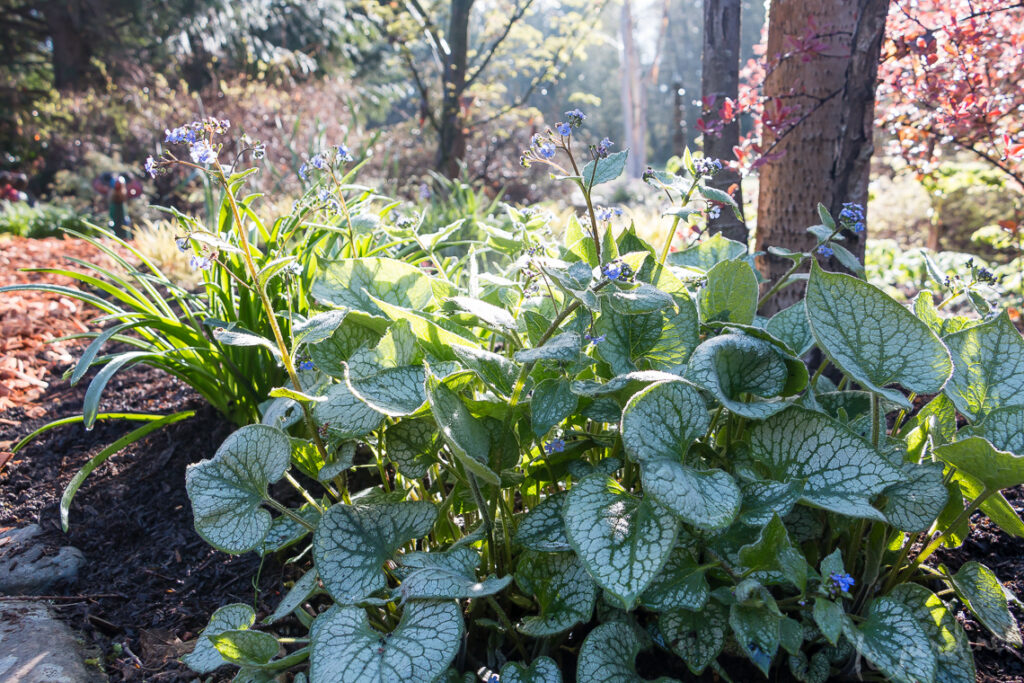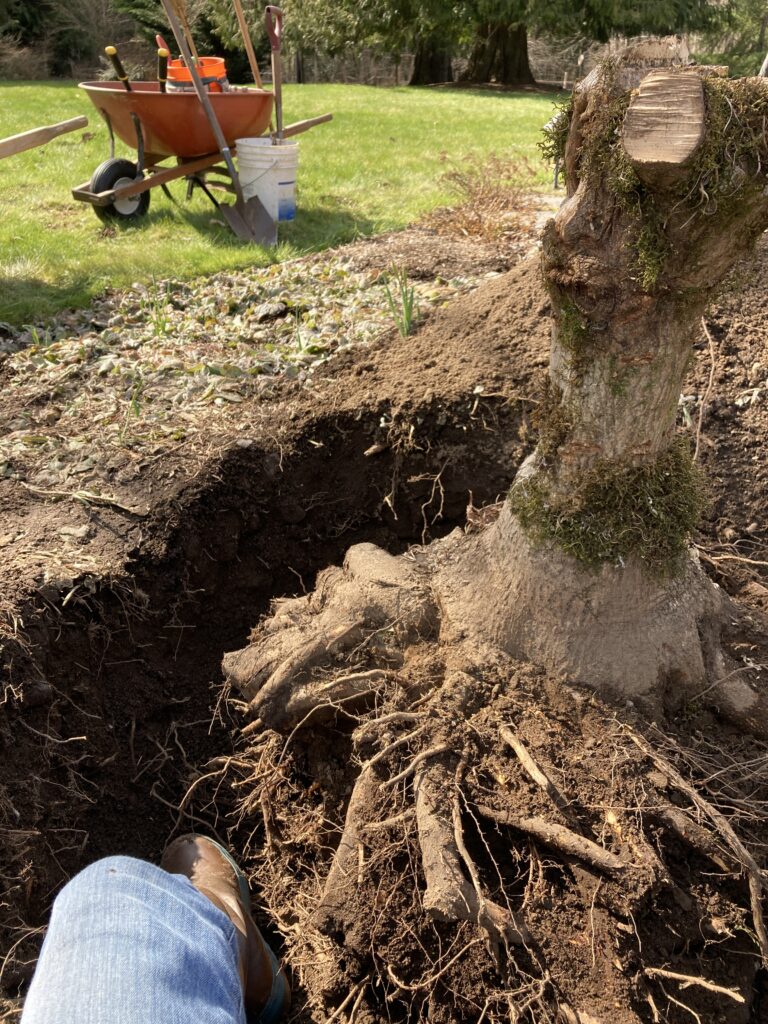Solutions for "Spring Overwhelm"

I've had a significant number of emails and conversations this week that all boil down to
"Help! I can't manage it all anymore!"
It happens this time every year. The sun finally shines, we head outside and are suddenly confronted by the realities of what has transpired during a long, wet, cold winter. In my own garden that includes long-dead summer annuals still in containers, the aftermath of December's ice storm still waiting to be dealt with (we lost 5 trees), a long list of shrubs that need moving from A to B, and a burgeoning crop of shot weed threatening to take over several beds. It's easy to feel overwhelmed because just like you I have a lot more to do than just look after our garden.
So let's take a hard look in the garden mirror and see how we got here, consider the solutions and learn how to stop it getting any worse.
Common Concerns – and Practical Solutions

Siberian bugloss is a great example of a low maintenance perennial. It offers seasonal blooms, great foliage, is deer and rabbit-resistant, drought tolerant and doesn't need regular division
"I never seem to make any headway"
If you start multiple projects at once – even if they are all part of your master plan – there is a significant chance that you will feel overwhelmed by the lack of visible progress. You have simply spread yourself too thin. Unless you have hired a company to take your master plan from concept to completion you need to have a reality check about how much time you have to devote to your project. Two golden rules:
- Never clear an area unless you have time and materials to complete it immediately. Why? Because the weeds will quickly take over and you'll be back to where you started.
- Start and complete ONE area at a time so you have a sense of achievement and can see the results. That goes for weeding, renovating, etc.
"It's become too much work"
Life happens, things change, and we need to make adjustments. A number of factors can bring us to this point:
- Your lifestyle has changed – you now want time to travel, enjoy additional hobbies, spend more time with family. The hours you used to be able to devote to gardening have therefore reduced.
- Your health has changed – or the reality has sunk in that you're not 21 anymore.
- You simply don't enjoy working in the garden anymore – it has become a burden rather than a joy
I've never yet been asked to design a high maintenance garden….. yet homeowners often come to the realization that they have created just such a monster themselves after decades of random plant buying sprees. Here are some of my top solutions:
- Ask for help – and accept less than perfect. Bring in a maintenance crew each spring and fall to take care of the two major seasonal clean-ups, leaving you free to do the more creative things such as plant a few containers or simply sit in the garden! But do be ready to lower your expectations as it is unlikely that anyone will do things quite as carefully as you would do.
- Skip growing vegetables for a year – or buy starts rather than growing from seed. Support your local farmer's market instead.
- Consider eliminating or reducing the size of a garden bed, especially if it is in an area that you don't see very often.
- Understand what characteristics make plants higher maintenance – and stop buying them! I have a popular online course that you can take – and re-take – at your convenience: Secrets to Selecting Low Maintenance Plants. I created it for this very reason.
- Simplify – it takes less time to look after groups of similar plants
"I don't know where to start!"
Trust me – you are not alone. I've said the same myself. Just this past weekend I had to choose between weeding, getting two tree stumps out (so I could replant the borders – which in turn meant a lot of transplanting), pruning, seed starting, cleaning up veggie beds, planting onion starts and emptying containers.
- I tackle it by doing garden triage. I start by making a list of what needs to be done then rank them in order of priority. From the list above my priorities were weeding shot weed (because it was in flower and ready to scatter even more seed) and removing tree stumps in order to complete major transplanting and planting while we still have reliable rains (we don't have an irrigation system). Dead plants weren't going anywhere, onions could wait another day, seeds could be started on a rainy day and I wasn't ready to plant in the veggie beds anyway. Pruning will be my phase 2 of the triage, scheduled for this week
- If you are embarking on a master plan the solution is somewhat different. You need to start with the hardscape – patios, pathways, retaining walls etc. This is the biggest ticket item but it won't be any cheaper next year I assure you. The good news is that it immediately instills a sense of order, which in turn will give you a sense of satisfaction. After that get your trees planted as they take the longest to become established – but go back to my very first point: never clear a new garden bed unless you are ready to plant it or it will just be a field of weeds. I also top dress new beds with a mulch to help suppress weeds and conserve moisture.
- Pace yourself. never work for more than two hours without taking a short break (there's a reason us British enjoy our tea breaks!) To avoid over-tiring your body also be sure to mix up the activities such as bending with those that allow you to stand upright such as raking or pruning.
Planning for the Future
Imagine yourself ten years from now. How might your health be? Will you be retired? What does retirement look like – a second home? More travel perhaps? Finally take up golf/swimming/ hiking? Will you have financial resources to bring in help for the garden if you need it?
Avoid creating a garden monster that seems to control your life and take steps today to ensure your garden will be one that you can be proud of and that brings you joy.
Subscribe to Receive Blog Posts
Gardening inspiration delivered right to your inbox from Le Jardinet


Really good advices. Than you!
You're welcome!
Great advice and just the pep talk I needed right about now.
I think we all need to hear it – including me!
muchas gracias Karen ! tus consejos son muy valiosos y acertados .A pesar de vivir en el hemisferio sur y estar en contraestación ( hoy comienza el otoño )
entiendo que tenemos un clima parecido , veranos cálidos y secos , otoños lluviosos e invierno frio con nieve . Siempre es un placer recibir tus mails . Vivo en Bariloche , Argentina .
Hi Graciela – yes no matter which country or hemisphere we live in, we all need to be reminded. Take care
Awesome Karen!
I love your articles. I've gardened long enough to have experienced your examples. Great advice – Read & Heed Karen's sage advice !!! Happy Spring
We will be in Seattle soon; I often think of your gardens when I see the beautiful Pacific Northwest gardens.
Well now you know it is far from magazine worthy atm LOL!
Thanks so much Michelle – glad you found this helpful even just as a reminder to breathe~